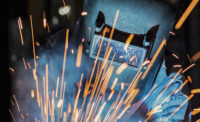Every arc flash analysis is not created equal, and the only way to know that your organization is getting its money’s worth is to recognize the best features of a sensible arc flash analysis plan as well as the potential pitfalls.
Work with a qualified contractor you trust
The first rule of thumb is to pick a contractor you can be comfortable with over the long term. Right now you may only be concerned with getting an initial analysis done, but compliance is an ongoing requirement. That means every time your facility experiences a change to its electrical system. The NFPA 70E standard requires that all major modifications or renovation shall be updated in the analysis or “not to exceed five years.”
The alternative to picking a long-term partner is orienting a new contractor every time you need to update your analysis. Each time you work with a new contractor, you increase your potential for wasting time and money. Remember, not every contractor sends out qualified electrical data collectors and even when they do, the “estimating” part of arc flash analysis is not an exact science.
That’s because data collection points (aka: “points”) can be counted differently by each contractor. One may be estimating based on counting every nameplate or where the label will go, while another only estimates for those points with protected devices. The only way to be sure you’re comparing apples to apples when having the project quoted is to have a clear scope of work defined and a definition of what you consider a point.
Managing change
As you consider whether a particular arc flash analysis contractor is the right one for your facility, be sure to inquire about the contractor’s plan for managing change—in real time and over time. It’s not practical to hire a contractor to come in and document change every time it happens after the fact. And doing “wall-to-wall” system audit every year can be very expensive.
That’s why many companies with defined change management programs find it easier to manage change as it happens. For example, a facility will require as part of the scope of work for a new electrical installation such a new industrial air compressor be installed that the installer documents and catalogs all the required data that will be need to update the analysis --i.e., wire size, wire length, fuse or breaker types or settings.
This approach is very effective because making the documentation a required part of the final deliverable means that the job is not complete until the data is received. However, are you an expert at looking at arc flash data and will you be able to tell if it is incomplete information? Or another pitfall might be that the contractor you hired to install the air compressor might not be qualified to collect the correct data.
Cataloging software
Qualified data collectors are even more effective if they arrive at your facility armed with cataloging software program designed specifically for conducting arc flash analyses. Cataloging software is invaluable on three levels — data collection, label installation and change management.
First, a good cataloging software will alert the data collector if not all of the data is collected for each point. This assures that all of the data is captured the first time.
The next benefit is correct label installation. Arc flash data collection software has the ability to capture photographs with each point and generate a report so that you have an absolute visual reference where to install each label.
Last, the software can be used to manage change. With arc flash data collection software it becomes very easy for any qualified installer to document the new circuit they have added by simply recreating it within the software and answering the questions as they go. This type of software assures that no data is missed.
Look for a contractor who can provide safety training for your employees
Nowhere is it written that your arc flash analysis provider has to be a huge conglomerate to be able to provide valuable training on the NFPA70E safety standard. In fact, you should expect that any full-service arc flash analysis contractor can also provide training for your employees. As you review their available training options, don’t settle for generic safety training; instead, consider a contractor who can provide safety training specific to your facility or environment.
A truly beneficial training program doesn’t rely on simply lecturing to your employees about the OSHA regulations or how the standards groups arrived at the calculations for the analysis. Instead, the best trainers will focus on the information qualified workers need to do their jobs efficiently and safely.
For example, qualified workers need to be trained in reading and interpreting all the information that appears on a best practices label and what that means in their specific environments. In addition, they should be trained in the practical application of protective measures; for example, with regard to how to properly operate and disconnect switch, field test a voltage rated glove or inspect the arc rated gear.
When you consider all the different aspects that go into selecting an arc flash analysis contractor and the potential pitfalls that loom in the background if you do try to cut corners, it is easy to see why the best arc flash analysis contractor is more than a contractor—they are a partner.



